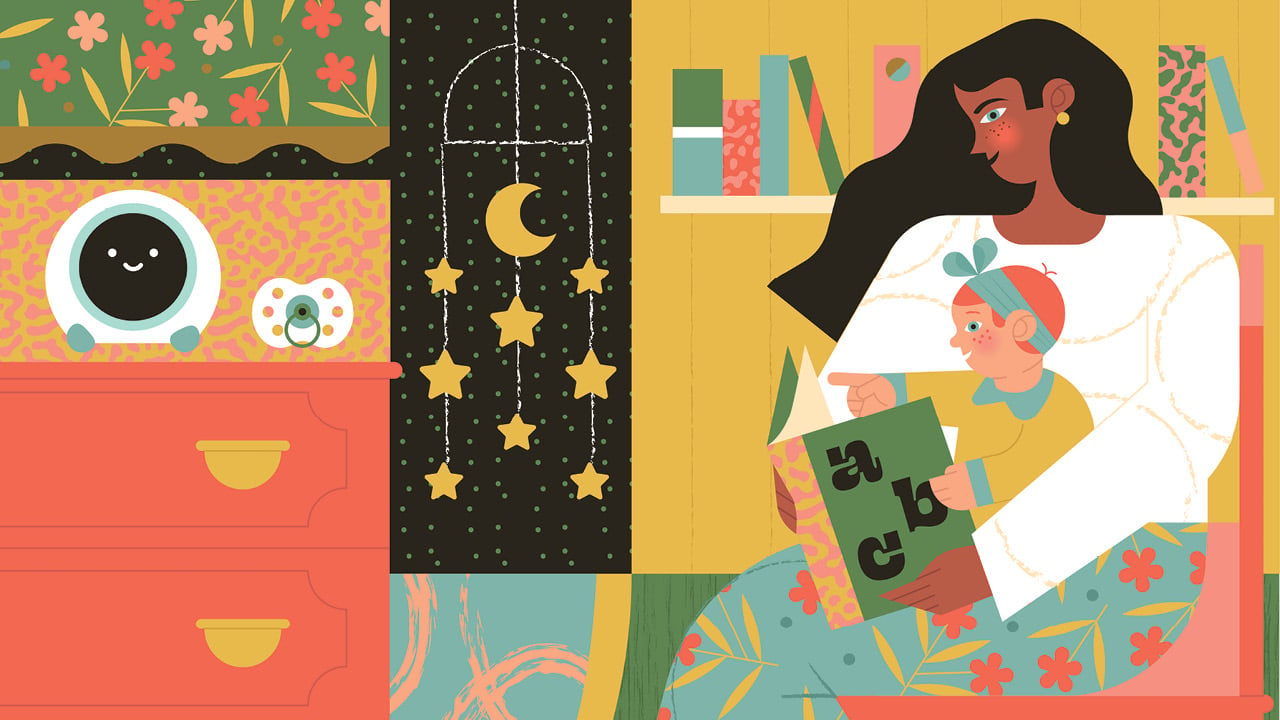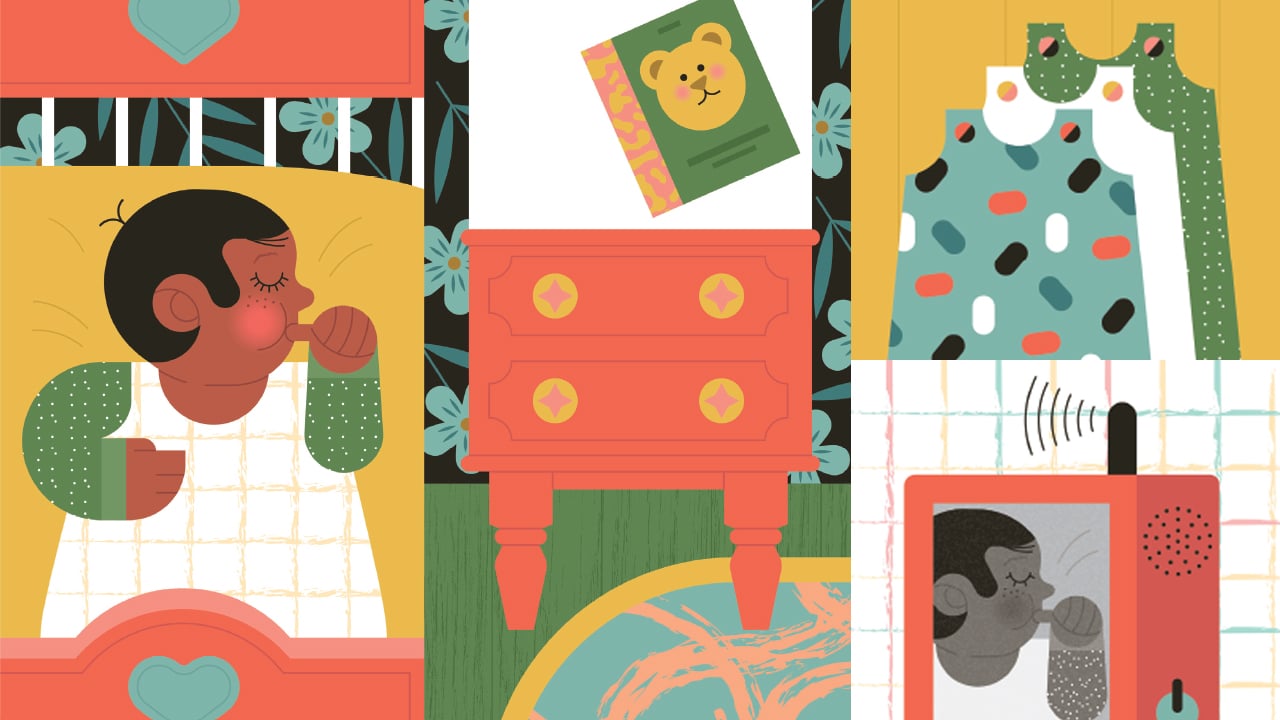Products You May Like
We can’t guarantee your baby will sleep through the night (there’s a huge age range for that!), but these nine nursery tips will help set them up for a successful slumber.
When you’re designing a nursery, it’s fun to focus on the aesthetics, scanning Instagram and Pinterest for just the right paint colours, decals and bedding. You’ve probably seen cribs draped with blankets and coordinating bumper sets, styled with cute stuffies and pillows. But did you know that that’s not, actually, what a safe sleep space should look like? You’ll also want to consider practical, decidedly less-cute items like blackout blinds. We can’t guarantee that the following tips will miraculously get your baby to sleep through the night—there’s a huge age range for that—but here’s how to make sure your baby’s bedroom is an ideal sleep environment.
1. An empty crib
Before babies reach six months old, they should sleep in the same room as their parents, but not in the same bed (that’s called co-sleeping or bed-sharing). No matter how old your baby is, make sure they’re sleeping in a crib or flat bassinet, not in a swing or car seat (which can lead to asphyxiation) or a playpen (which is not supposed to be used for unsupervised sleep). For the first year, there should be nothing in the crib but baby; that means no pillows, toys, blankets or crib bumpers (even the mesh kind).
2. No night light
While a night light might seem like a classic decor item in a baby’s room, babies aren’t afraid of the dark—and sleep experts say night lights, projectors and crib aquariums can interfere with sleep. “I don’t recommend night lights for younger babies, but some preschoolers do get very afraid of the dark,” says Wendy Hall, a sleep specialist and professor emerita at University of British Columbia’s School of Nursing. If you do use a night light, she says, tuck it behind something so it offers a soft glow and is less distracting.
3. A baby bundled just right
Since blankets aren’t safe for sleeping babies, the American Academy of Pediatrics suggests dressing your baby for bed the same way you would dress yourself for bed, plus one additional layer. Consider a swaddle or a sleep sack. Swaddling may help younger babies calm down, but it needs to be done properly to be safe.
Sleep sacks are a safe outer layer that mimics a blanket. They come in a variety of warmths, often measured in togs—0.5 togs is lightweight for summer, 1 tog is in the middle, and 2.5 togs is for winter. Make sure the sleep sack is the right size so it can’t work its way up over your baby’s head.
4. A baby monitor
While you don’t need a baby monitor for safety reasons, some parents feel it can help with creating good sleep habits. If you have one with a video monitor, you can check the screen instead of entering their room after every movement and teeny yelp, and, ideally, watch your baby swiftly and safely resettle on their own without you worrying or intervening. You may also be able to see if they lost their binky, for example, or got a leg stuck in the crib bars. Look for a monitor that accurately tracks the room temperature—maintaining a cool, comfortable temp around 21C helps your baby sleep better, since our core temperature naturally drops at night. A cooler room temperature can also help prevent sudden infant death syndrome, better known as SIDS.

Illustration: Delphine Meier
5. Blackout blinds
It’s important that babies sleep in a dark space—darkness triggers your child’s melatonin hormone, which is released every night and helps them feel sleepy. While some babies are fine in a room that’s just darkened with regular blinds or curtains, many sleep consultants recommend blackout blinds to completely darken the space, especially for naps and in the summer months, when it’s light out for several hours past a typical baby bedtime. In the mornings, the blinds help prevents early wake-ups triggered by the room getting brighter.
6. A consistent schedule
Wake your child at the same time every day, and keep bedtimes consistent, too. While newborns go to bed notoriously late, an older baby’s ideal bedtime is probably earlier than you think. Janey Reilly, the CEO of WeeSleep, suggests no later than 7 p.m. for babies age four months to two years, while other consultants say 7:30 p.m. is the sweet spot for most kids. For older babies and toddlers, a Gro-Clock or OK to Wake Clock can be helpful—they can be set to change colours at your desired wake-up time, providing a concrete signal to kids that it’s morning.
7. Pacifier
Years ago, parents were advised to not use pacifiers because of the potential for “nipple confusion” affecting breastfeeding, but more recent evidence suggests nipple confusion due to pacifier use is a myth. And nowadays, both the American Academy of Pediatrics and the Canadian Paediatric Society actually recommend using pacifiers to reduce the risk of SIDS. But some sleep consultants, like Reilly, say you’re setting yourself up for replacing that pacifier all night long if your baby is not old enough to put it back in their mouth themselves. (Some parents use the glow-in-the-dark kind or scatter a bunch in the crib.) Bottom line: A pacifier is optional.
8. No ceiling projectors or fancy light-up mobiles
Toys like crib aquariums and light-up ceiling projectors are entertaining for babies, but they shouldn’t be used at bedtime, says Reilly. “They’re very stimulating—we want the baby to understand that the crib is for sleep and not for play,” she says. Securely installed mobiles are fine—just make sure they don’t have small parts, which could come off and become a choking hazard, and to lower the crib mattress when your baby starts to be able to sit up and grab for the mobile.
9. A bedtime routine
If your baby is three months or older, start a regular 15- to 30-minute (max!) routine that you can do every night and replicate from anywhere for months and years to come—even as your baby grows into a toddler. A sample routine might be brushing teeth, changing into pyjamas, dimming the lights, reading a few books, putting on the sleep sack, placing your child in the crib and then singing a soothing lullaby. (Starting with a bath can help, since it’s usually a nice calming activity.) While nursing or cuddling in the rocking chair is a lovely way to provide comfort before bedtime, after babies are about six months old, most experts don’t recommend nursing or rocking them fully to sleep and then attempting to transfer them to the crib, because they’ll learn to associate rocking, nursing or a bottle with falling asleep, and when they wake up again (and again) in the night, they’ll need to be fed or rocked back to sleep each time. Instead, finish any feedings before the bedtime routine starts, and try to end your routine by placing them in the crib awake.
